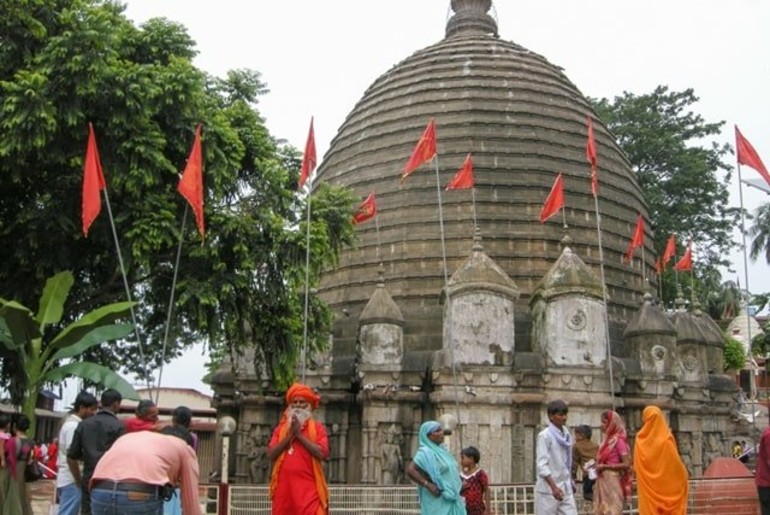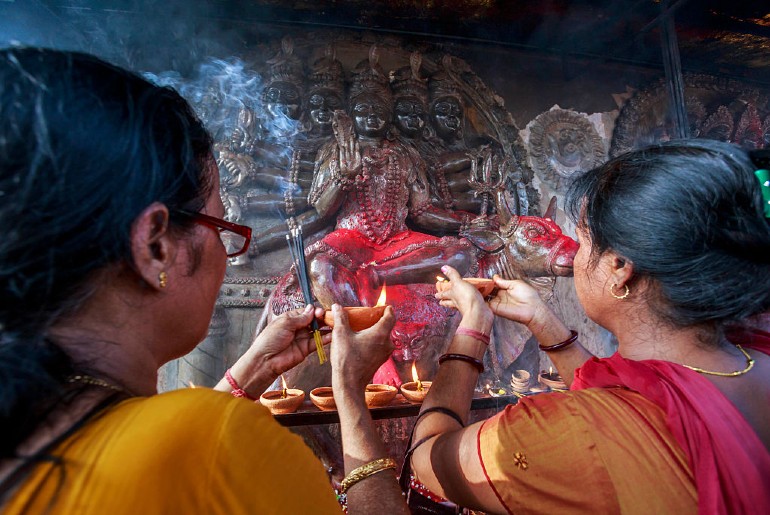Kamakhya Temple
This Indian Temple Celebrates It’s Menstruating Goddess Breaking The Stigma Around Periods

In our country, menstruation has long been surrounded by taboo and stigma. However, there is a remarkable exception that challenges these norms. In Assam, there exists a temple that not only acknowledges menstruation but actually celebrates it. This might sound surprising, but it’s a reality. The Maa Kamakhya Devalaya Temple in Guwahati is dedicated to the worship of Kamakhya or Kameswari, a form of the goddess Shakti. While the worship of Shakti is a common aspect of Hinduism, what sets this temple apart is its unique reverence for the menstruating Goddess.
This unconventional perspective holds a fascinating story. The temple’s practices involve the acknowledgment and celebration of the natural biological process of menstruation. This stands in contrast to the prevalent social taboos that often surround menstruation in various cultures. The temple doesn’t view menstruation as impure or something to be hidden away, but rather as a natural and integral aspect of a woman’s life.
By venerating the menstruating goddess, the Maa Kamakhya Devalaya Temple challenges stereotypes and promotes a more inclusive and progressive outlook on womanhood. This practice not only empowers women but also questions the deeply ingrained societal norms that have perpetuated the stigma around menstruation.
In a broader context, this temple serves as a symbol of change and enlightenment, challenging traditional notions and encouraging conversations about menstruation and gender equality. It highlights the potential for cultural shifts that can promote acceptance, understanding, and respect for all aspects of human experience.

Maa Kamakhya Devi is situated atop the Nilachal Hill in the western part of Guwahati, Assam. This revered deity holds a distinctive place among India’s pilgrimage destinations. Unlike many other temples, Maa Kamakhya’s shrine doesn’t house a conventional idol. Instead, the focal point of worship is Maa Kamakhya’s yoni, which symbolizes her vagina or the vulva of Goddess Sati.
Within the temple’s innermost chamber, known as the sanctum sanctorum, the stone representing Maa Kamakhya’s yoni is positioned. Interestingly, this stone is constantly kept moist by water from an underground spring. This phenomenon adds to the mystique and sacredness associated with the temple.
The symbolism behind this unique form of worship is deeply rooted in Hindu mythology and spiritual beliefs. The yoni is considered a representation of the divine feminine energy and the creative power of the goddess. It signifies the origin of life, fertility, and the cycle of creation. By worshipping Maa Kamakhya’s yoni, devotees acknowledge the primal force that underlies the universe and pays homage to the interconnectedness of life.
This practice invites contemplation about the cycle of birth, existence, and renewal. It also emphasizes the importance of embracing all aspects of life, including those that might be considered unconventional or uncomfortable. The temple’s architecture and rituals surrounding the yoni are a reflection of the broader acceptance and veneration of the female body and its natural processes.
In essence, the worship of Maa Kamakhya’s yoni serves as a unique representation of the divine feminine and the intricate interplay of spirituality, symbolism, and nature within Hinduism.

Maa Kamakhya is one of the revered 51 Shakti Peeths in India. These Shakti Peeths are significant pilgrimage sites in Hinduism, each associated with a specific part of the divine goddess. The story behind Maa Kamakhya’s connection to the Shakti Peeths is rooted in Hindu mythology and showcases the intricate tapestry of tales that form the backdrop of these sacred sites.
According to the legend, Sati, the wife of Lord Shiva, had a strong desire to attend her father’s grand yagna (sacrificial ritual). Despite Shiva’s reluctance, Sati went against his wishes and attended the yagna. However, during the event, Sati’s father did not extend an invitation to Shiva, which deeply offended him. Feeling dishonored and outraged by the insult to her husband, Sati could not bear the emotional turmoil and immolated herself.
In his anguish, Shiva picked up Sati’s lifeless body and began performing the destructive Tandava dance, which symbolizes the cycle of creation and destruction. Lord Vishnu intervened to calm Shiva down and used his chakra (discus) to dismember Sati’s body. Her body parts fell at 108 different locations across the Indian subcontinent, each becoming a Shakti Peeth, a site of immense spiritual significance.
The specific body part associated with each Shakti Peeth varies, and in the case of Kamakhya, it is said that Sati’s womb and genitals fell on the Nilachal Hill in Assam. This site later became known as Kamakhya and is now revered as one of the prime Shakti Peeths.
The story underscores the deep emotions, divine connections, and symbolism present in Hindu mythology. The Shakti Peeths hold a place of reverence for millions of devotees who visit them to seek blessings, spiritual solace, and a connection to the divine feminine energy.

The Maa Kamakhya Temple is renowned for its annual festival called Ambuwasi Puja, which is centered around the theme of fertility. During this unique celebration, the Goddess is believed to undergo her yearly menstrual cycle. The temple is closed for three days as a symbolic representation of the Goddess’s menstruation, and then it reopens with elaborate and joyful festivities on the fourth day.
A fascinating natural phenomenon is associated with this festival. The river Brahmaputra, which flows nearby, reportedly turns red during this time. This occurrence is seen as a sign indicating the menstruation of the Goddess, and it’s considered a part of the sacred connection between the deity and the environment. The red color of the river symbolizes the bleeding Goddess, and as a result, the temple remains closed during these days.
There are differing explanations for the river’s transformation. Some believe that the iron-rich soil of the riverbank reacts with the water and turns it red, particularly during the monsoon season. On the other hand, there’s also a belief that the priests put vermilion (a red powder commonly used in Hindu rituals) into the river to symbolize the Goddess’s menstruation.
The Ambuwasi Puja is not only a religious event but also a cultural and ecological phenomenon that captivates the attention of people. It showcases the deep connection between mythology, nature, and spirituality, underlining the intricate ways in which these elements intertwine within Hindu traditions. The festival serves as a testament to the temple’s unique approach to embracing and celebrating the natural processes of life, even in their most symbolic forms.

During the three days of the Ambuwasi Puja festival at the Maa Kamakhya Temple, the inner sanctum of the temple is draped with red cloth, creating a visual representation of the menstruation of the Goddess. This ritualistic covering with red cloth is a symbolic act that aligns with the theme of the festival.
During these days, the Goddess is honored with offerings of special foods. Devotees, including Baul singers, sanyasins (ascetics), and numerous other worshippers, gather around the temple complex, eagerly awaiting the culmination of the festival.
On the fourth day, which marks the end of the menstruation symbolism and the reopening of the temple, devotees come to seek blessings from the Goddess. This day is marked by grand celebrations, where the atmosphere is filled with vibrant colors, fervent prayers, and a sense of spiritual joy. The deity’s blessings are sought for various aspects of life, including fertility, prosperity, and well-being.
One of the significant aspects of the festival is the distribution of holy water. After the temple reopens and the Goddess’s blessings are invoked, the sacred water, which is believed to carry the Goddess’s divine energy, is distributed among the devotees. This blessed water holds spiritual significance, and those who receive it consider it a source of protection and blessings.
The Ambuwasi Puja festival, with its rituals, symbolism, and enthusiastic participation of devotees, showcases the multifaceted nature of Hindu traditions. It combines religious practices, cultural festivities, and a deep spiritual connection between the worshippers and the divine feminine energy represented by Maa Kamakhya.
